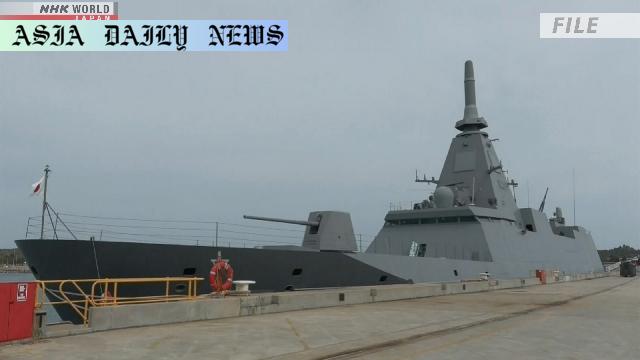Frigate: Australia partners with Japan for advanced naval fleet development in $10 billion project targeting 11 state-of-the-art ships.
Australia selects Japan’s Mogami-class frigate for its new naval fleet.
The $10 billion project plans to develop up to 11 cutting-edge vessels.
This partnership marks a milestone in Australia-Japan relations.
Japan’s proposal was selected for its advanced capabilities and efficiency.

Australia’s Strategic Partnership with Japan
In a landmark move to enhance its naval capabilities, Australia has selected Japan as its strategic partner for developing a new fleet of frigates. This decision underscores the deepening ties between the two nations, further solidifying their relationship in the realm of defense and security. The collaboration will be centered around Japan’s state-of-the-art Mogami-class frigate, a vessel renowned for its stealth, advanced radar, sonar technology, and missile systems. The Australian government, under the leadership of Defense Minister Richard Marles, has emphasized the importance of leveraging these capabilities to ensure the optimal performance of its navy. The ambitious project entails an investment of 10 billion Australian dollars, translating to approximately 6.5 billion US dollars, with the goal of introducing up to 11 cutting-edge ships to replace an aging fleet.
Advantages of the Mogami-Class Frigate
The Mogami-class frigate offers several advanced features that make it a fitting choice for Australia’s naval ambitions. Notable qualities include its stealth design, which enhances operational security, as well as its exceptionally efficient radar and sonar systems that bolster situational awareness. The vessel is also engineered to function with a comparatively smaller crew, reducing manpower requirements while maintaining efficiency and effectiveness. These attributes were key factors influencing Australia’s decision to pursue this partnership. Furthermore, the project aligns with Australia’s strategic objective of modernizing its navy with vessels that are not only technologically superior but also versatile enough to adapt to evolving security challenges in the Indo-Pacific region.
Strengthening Bilateral Relations
The collaboration between Australia and Japan signifies more than just the development of a sophisticated naval fleet; it represents a pivotal moment in bilateral relations. Both nations have been striving to deepen their strategic cooperation, and this project serves as a concrete step in that direction. Japan’s Defense Minister Nakatani Gen has lauded the partnership as a ‘big step’ that will elevate security cooperation with Australia, a ‘special strategic partner.’ This collaboration is indicative of the shared commitment of both governments to not only bolster their defense capabilities but also showcase their technological and industrial prowess on a global scale.
Economic and Security Implications
The deal also has substantial economic and security implications for both countries. For Japan, this represents one of the largest defense equipment export deals, showcasing its ability to compete on the global stage. Japan’s government and private-sector involvement underscores the seriousness of its commitment to the project. For Australia, the deal is a step towards ensuring maritime security in an increasingly contested Indo-Pacific region. As the geopolitical landscape continues to evolve, such collaborations are essential for countries seeking to maintain stability and protect key trade routes.
Looking Ahead
While the finalization of this ambitious deal is expected in early 2026, the groundwork for this partnership lays out a roadmap for future collaboration between Australia and Japan in the fields of defense and beyond. The project serves as a reminder of the importance of alliances and strategic partnerships in addressing modern security challenges. As both nations work together in the coming years, the collaboration will likely yield valuable insights and pave the way for further innovation in defense technology.



Commentary
A Progressive Step for Both Nations
The announcement of the partnership between Australia and Japan to develop the Mogami-class frigates is nothing short of a watershed moment in their bilateral relationship. It reflects not only the shared strategic goals of the two nations but also underscores the growing reliance on defense collaborations to address modern security concerns. This partnership reaffirms the importance of global alliances in promoting stability and security, particularly in the Indo-Pacific region, where maritime disputes and intensifying power dynamics necessitate strong naval capabilities.
Enhancing Naval Efficiency through Innovation
One key point of interest in this collaboration is the technological sophistication of the Mogami-class frigates. Japan’s emphasis on efficiency through reduced crew size and advanced sonar and radar capabilities brings a new dimension to naval operations. For Australia, this development signals a transition to a more modern and agile fleet capable of coping with rapidly changing maritime threats. Such initiatives also reflect a rising trend globally, where nations prioritize cutting-edge technology to enhance security without escalating manpower requirements significantly.
A Pivotal Moment for Defense Cooperation
Australia’s decision to select Japan for this project is telling of the trust and confidence shared between the two nations. It marks a significant advancement in their defense diplomacy and indicates the potential for future collaborations in technological and industrial fields. This move not only strengthens bilateral ties but also sets an example for other like-minded nations to engage in mutually beneficial partnerships that enhance collective security in uncertain times.